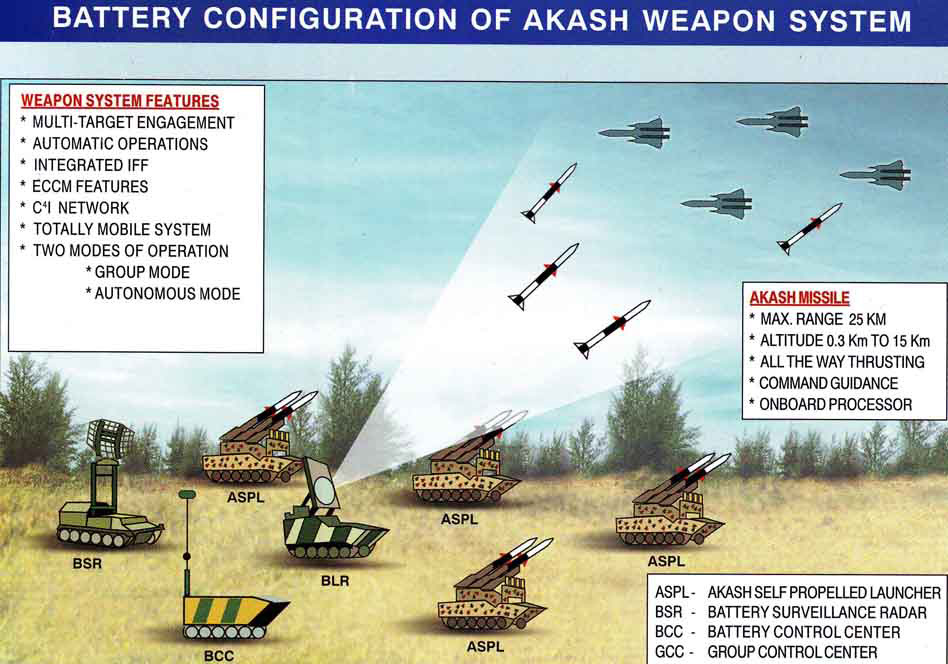http://knol.google.com/k/vijainder-k-thakur/akash-missile/yo54fmdhy2mq/57#
Akash Missile
Medium range mobile anti-aircraft missile
Basically an upgraded Russian SA-6 system, the Akash is a command guided missile system that has been under development by DRDL for 25 years, and has already cost Rs. 516.86 crore, the highest for any of India's missile systems.
Contents
* Operational Status
* Missile Characteristics
* Development History
* Orders
* Additional IAF Order for Six Squadrons
* Future Development
Operational Status
Two squadrons of the missiles are operational with the IAF, an additional six are likely to be ordered soon (as of February 2010).
Each squadron will have two Flights equipped with four Akash launchers, and a total of 125 missiles. The total IAF order will now by for 1,000 missiles.
The Indian Army has shown interest in acquiring the missile. It is expected to order two Akash regiments with six firing batteries each, for around Rs 4,000 crore.
Missile Characteristics
The 720kg, 5.78-metre long missile has a diameter of 35 cm and a length of 5.78 meters. With a top speed of Mach 2.5, the missile can engage targets as far as 25 km away flying at heights ranging from 20m to 18kms.
The missile is supported by multi-target and multi-function phased array fire control radar called 'Rajendra' that has a range of about 60 km.
The Akash missile system is mobile, with the missile launcher, radar and command center all mounted on T-72 chassis.
The mobile command centre selects up to four of the most threatening air targets, and two Akash missiles are fired at each from the T-72 based Akash launchers, which move alongside. The Rajendra radar continuously guides the missiles, eventually “flying” them smack into the enemy fighters.
The Akash missile offers better maneuverability than typical surface-to-air missiles because it does not have a coast phase; it's boosted through out its flight envelope. According to DRDO, no other missile in the world offers this feature.
Development History
The first test flight of the missile was conducted in 1990, and since then many development and field trials have taken place.
The last field trials for the missile were conducted at Pokhran in Rajasthan in late 2007.
According to DRDO, the missile was tested 9 times during the last development phase and on all occasions met the guidance and accuracy control requirements.
However, the missile has consistently fallen short of IAF requirements, which wants a smaller, lighter missile with a longer range, greater maneuverability and an active seeker.
DRDO proposes to remove the shortcomings in the missile through batch-by-batch improvements.
Orders
Indian Air Force placed a Rs 1,200 crore order with Bharat Electronics Limited (BEL) for two squadrons of medium range, surface-to-air missile Akash in 2008.
Bharat Electronics will be the nodal production agency along with Bharat Dynamics and there will be at least 40 industries from the public and private sectors that will be involved with the manufacture of these missiles in large numbers.
The Indian Army is reported to be interested in acquiring several Akash squadrons for its ground forces.
The DRDO’s Chief Controller for R&D, Prahlada, told Business Standard in early November 2009:
“I cannot say whether the army is interested in the Akash for its strike corps, or for another role. In any case, the Akash is a mobile system that is suitable for various roles.”
Additional IAF Order for Six Squadrons
On February 2, Defence Minister A. K. Antony told the press that the Defence Acquisition Council in a meeting on Monday, February 1, had cleared acquisition of an additional six Akash squadrons for the IAF.
The six squadrons are in addition to the two procured by the IAF earlier, he said, adding that the order value would be around Rs. 5,000 crore.
He said the IAF, which initially had doubts about the missiles capability, was noq keen to acquire additional squadrons after having been satisfied with the performance of the missiles systems that it had acquired.
“They (IAF) are now happy. There were doubts in the past, but now they are becoming a reality,” he said;
Future Development
India wants to build a version of Akash for use on ships, and is already looking into a longer range (60 kilometers) version.

